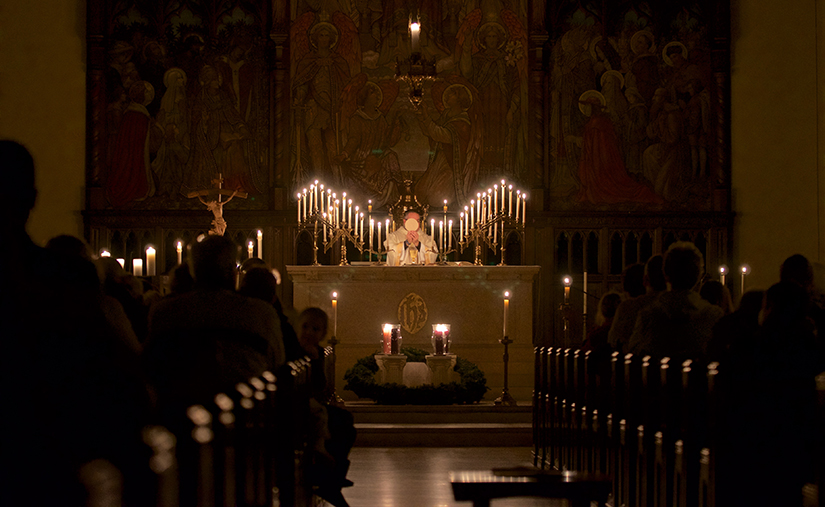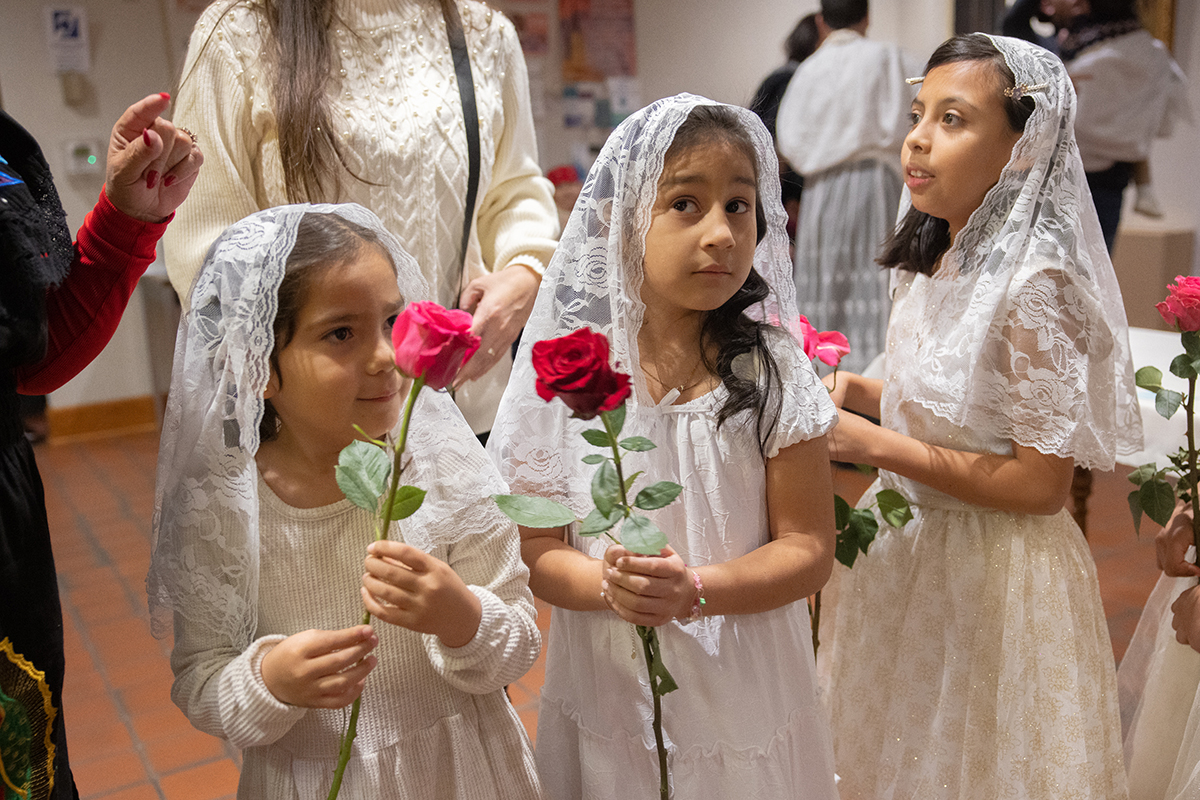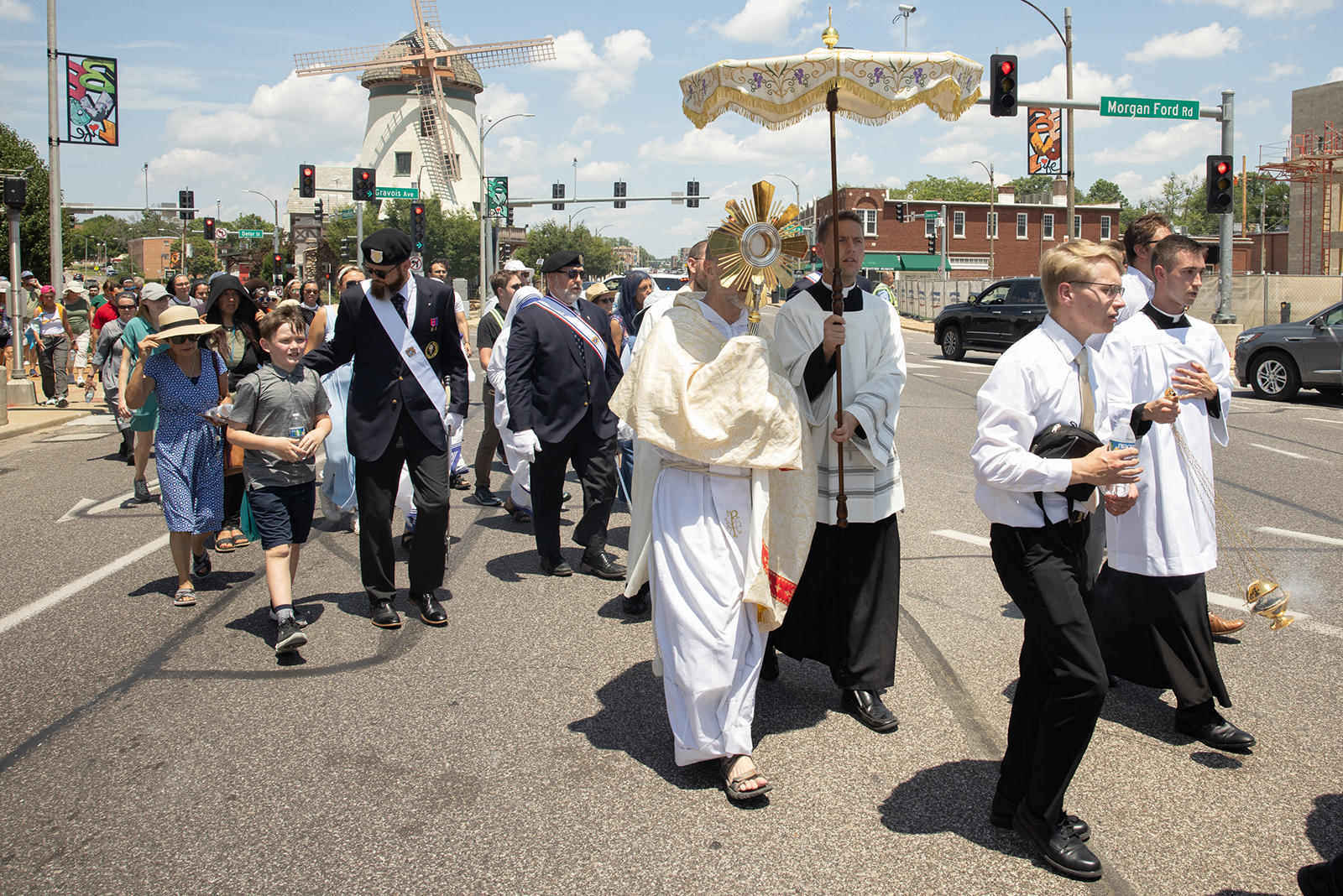From darkness to light

Rorate Caeli Mass evokes feelings of peace, calm in days before birth of Christ
Amid the last-minute preparations before Christmas, finding quiet time to prepare our hearts for the birth of Christ can be challenging.
In the weeks leading up to Christmas, parishes in the archdiocese have been offering that much-needed solace via Masses, prayer services, novenas, reconciliation services — you name it.
One of those Advent traditions, which has experienced a bit of resurgence in the archdiocese the last few years, is the Rorate Caeli Mass. The evening candlelight Mass honors the Blessed Virgin, in anticipation of the birth of Christ. Several parishes — including Assumption in Mattese, St. Joseph in Manchester and St. James the Greater in Dogtown — held Rorate Masses in the week leading up to Christmas.
Theresa Leisure, who with her family attended the Dec. 21 Mass at Assumption, called it an opportunity to put any stress behind her and focus on the real meaning of the holiday.
“It was a beautiful tradition that I’ve never experienced before,” she said. “It was certainly heartwarming and just calmed my whole being.”

Rorate Caeli comes from the Introit, or entrance chant, used during Advent from Isaiah 45:8 — “Roráte caeli désuper, et nubes pluant iustum.” (“Drop down dew, ye heavens, from above, and let the clouds rain the just.”) The Mass is an opportunity to reflect, through the liturgy, on Mary’s role in salvation history.
Historically, the Rorate Mass would be celebrated by candlelight before dawn. The sun rising at the end of Mass symbolized the journey from darkness to light and the coming of the infant Jesus, the light of the world. For practicality sake, the Mass is now generally offered in the evening.
Before the liturgical changes that stemmed from the Second Vatican Council, Masses were typically celebrated very early in the morning on all Saturdays. In some areas it was celebrated on several or even all weekdays during Advent. (In the old Missal, it’s called the Votive Mass of Our Lady in Advent.)
“This is part of the tradition of keeping vigil and preparing for the coming of the bridegroom — the coming of Jesus,” said Father Thomas Keller, pastor at Assumption. “The idea of keeping our lamps lit, and our minds, our hearts, our souls prepared for the coming of Jesus — it speaks to people.”
About 100 people attended a Dec. 17 Rorate Mass at St. James the Greater. In his homily, Father Chris Dunlap spoke about the anxiety that can come with waiting. “When we wait in the quiet, the peacefulness of the Mass slows everything down and takes away our anxiety,” he said. “In some little way, hopefully there was a calming influence of the environment. We all came into the world in the same way — we’re all born the same way, just like Jesus. Likewise, we are all in need of Jesus, all in need of a savior.”
At St. Joseph in Manchester, Father Michael Joseph Houser noted in his homily that the Mass was a moment to “step outside of the ordinary and contemplate the mystery of God.”
“This Mass is traditionally celebrated in honor of the Blessed Mother — she is the one who is best able to help us prepare to receive Christ,” he said. “This Mass is meant to help us to join her in that spirit of expectation that was in her heart in the weeks prior to the birth of Jesus.”
A similar Advent tradition in the Filipino culture is Simbang Gabi (Night Mass), a nine-day series (novena) of Masses in anticipation of Christmas and to honor the Blessed Mother. Simbang Gabi was held Dec. 15-23 at All Saints Church in University City. Traditionally, Masses are celebrated in the early morning hours, but again, for practical reasons have been moved to the evening.
Old traditions take on new meaning in a modern world that desperately seeks peace and unity. The birth of our Savior brings light from darkness, hope from despair.
Sixteen-year-old Kimberly Daues, who attended the Mass at Assumption with her dad, Chris, and younger sister, Nichole, summed it up best: “I like how this goes back to the traditional ways,” she said. “Knowing this is how they did it way back in the days of the (early) saints, it makes me feel closer to the days Jesus was born.”

Story published January 2014
Rorate Caeli Mass is a first formal introduction to new religious community in St. Louis
There were 163 candles, to be exact, at a Rorate Caeli Mass celebrated at St. Martin of Tours this past Advent. But not many were counting. Rather, they were there to honor the Blessed Virgin, in anticipation of the birth of Christ.
This was the first time celebrating the Mass in St. Louis for members of the Oratory of St. Philip Neri, who came to the Archdiocese of St. Louis at the invitation of Archbishop Robert J. Carlson earlier this year. In June, the community was assigned to care for the needs of St. Martin of Tours in Lemay.
The Rorate Mass, noted parish administrator Father James Richardson, is a Mass offered during Advent in honor of Mary. The name comes from the Introit, or entrance chant, used during Advent from Isaiah 45:8 — “Rorate caeli desuper, et nubes pluant iustum.” (“Drop down dew, ye heavens, from above, and let the clouds rain the just.”)
The Mass is celebrated by candlelight, traditionally right before dawn. The sun rising at the end of Mass symbolizes the journey from darkness to light and the coming of the infant Jesus, the light of the world. For practicality, the community offered the Mass in the evening Dec. 19.
Father Richardson noted that the Mass is an opportunity to reflect, through the liturgy, on Mary’s role in salvation history. “What she does is gives it flesh, puts this into human terms,” said the priest, a native of Belleville, Ill., “This is more than a proposition, but a person.”
“With the liturgy, when we draw our senses into it, our faith becomes more than a set of propositions,” he said, noting the various elements of the Rorate Mass, including the dark, candlelit church; the chants of the schola, a choir that focuses on sacred chant; the incense used during Mass; and readings in both English and Latin. “This helps us get to the heart of the matter. Our hope is that we can find our place here in stirring the hearts of people.”
Father Richardson and Brother Edward Olsen arrived in St. Louis from Kalamazoo, Mich., last January. They initially assisted at St. Elizabeth of Hungary Parish in Crestwood before coming to St. Martin of Tours. The oratorians, as they’re called, belong to a society of apostolic life founded by St. Philip Neri in 1575. While the men live in community, they take no formal vows, other than a bond of charity.
Brother Olsen noted that the oratory is most commonly known for its interest in the liturgy, music and sponsoring the arts. While the two are still in the process of establishing the community here, it’s likely that their apostolates will focus on some of those areas.
“Our hope is that the community will become more familiar with the development of the (liturgical) rites,” said Father Richardson. Referring to “Sacrosanctum Concilium,” the Church’s Constitution on the Sacred Liturgy, he added, “our contribution is offering the liturgy in a way that demonstrates that the reforms of the rite should be developed organically.”
Adam Wright, who was hired in November as the music director at St. Martin of Tours, said that there’s been an interest from Catholics in the neighborhood. The oratorians offer a solemn Mass (including chanting by a schola) on Sundays at 11 a.m., as well as Masses at 4 p.m. Saturdays and 7 and 9 a.m. Sundays.
Wright, who led the schola at the Rorate Mass, said the best way to describe the oratorians’ approach to the liturgy is “probably a halfway point between a typical Novus Ordo Mass and what you would experience at St. Mary of Victories,” a Downtown church that celebrates the Novus Ordo Mass in Latin.
Wright noted that the parish also has an adult choir, a new children’s choir and women’s schola.
Story published December 2015 Amid the last-minute preparations before Christmas, finding quiet time to prepare our hearts for the birth of Christ can be challenging. In the weeks leading up … From darkness to light
Subscribe to Read All St. Louis Review Stories
All readers receive 5 stories to read free per month. After that, readers will need to be logged in.
If you are currently receive the St. Louis Review at your home or office, please send your name and address (and subscriber id if you know it) to subscriptions@stlouisreview.com to get your login information.
If you are not currently a subscriber to the St. Louis Review, please contact subscriptions@stlouisreview.com for information on how to subscribe.





